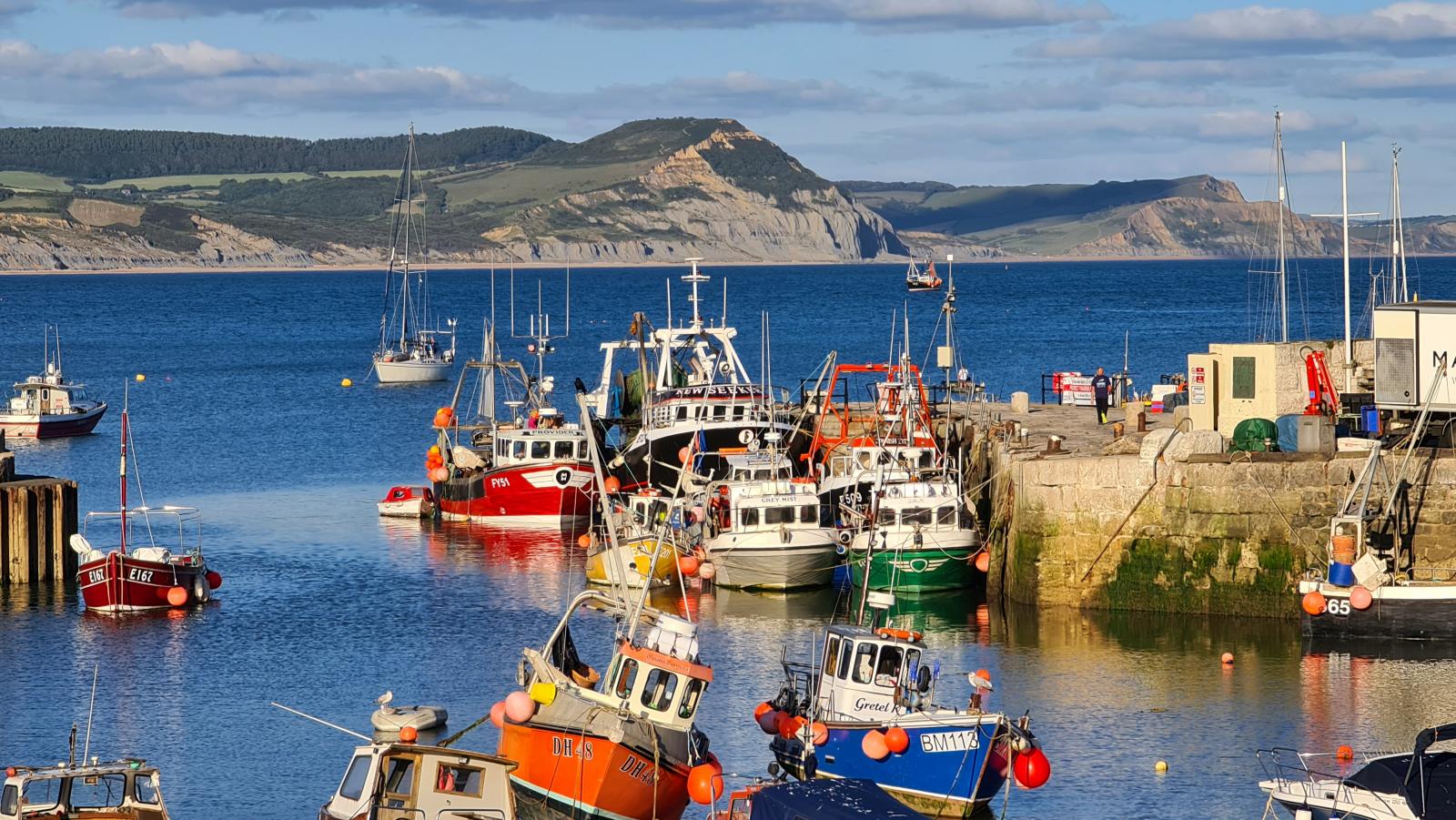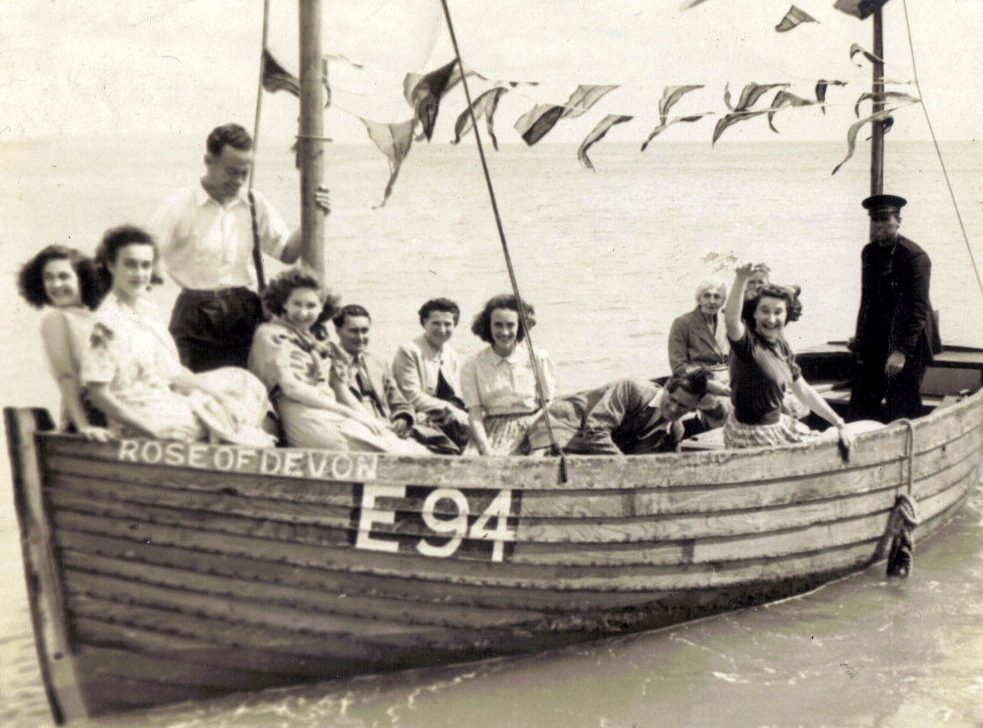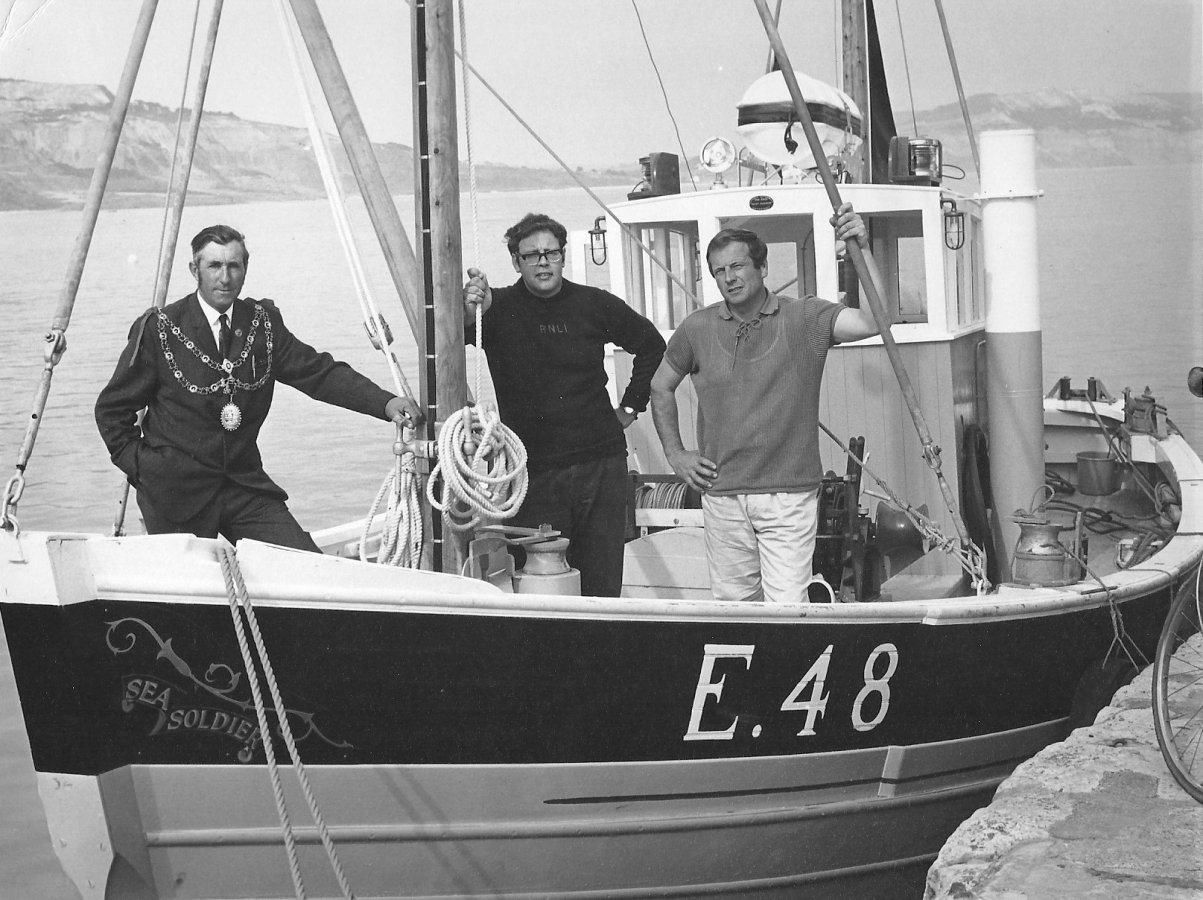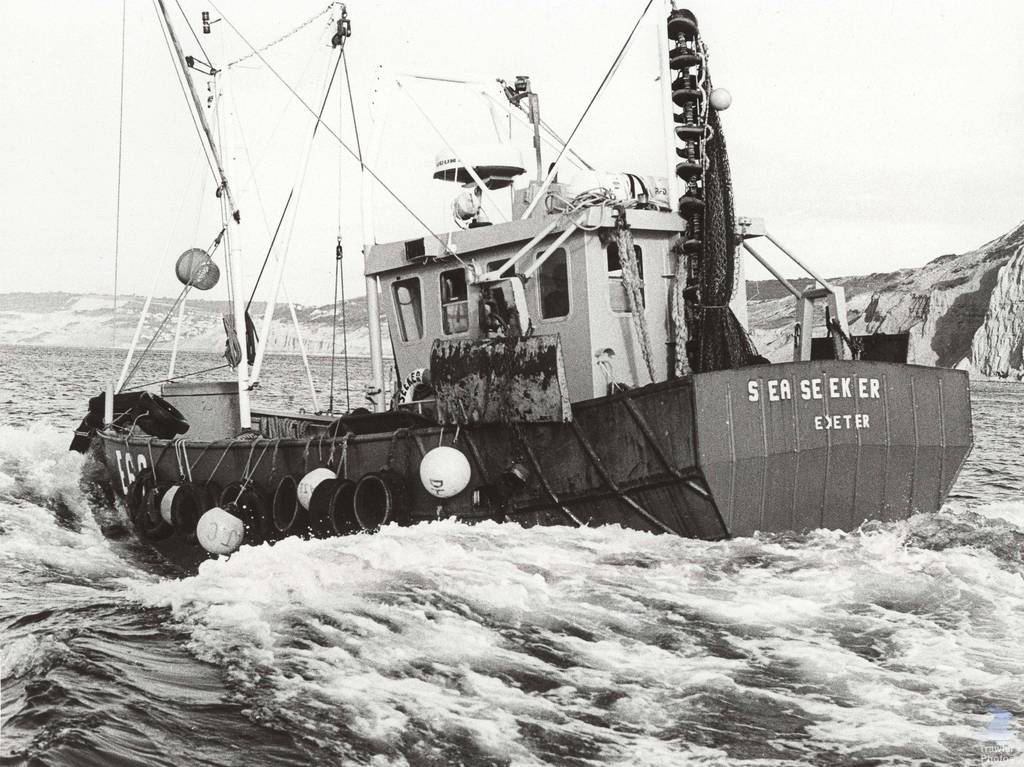Fishing Industry

The waters of Lyme Bay have been fished for centuries by the communities that line the coastline. It is home to many species of fish including bass, bream, cod, conger eel, dabs, huss, mackerel, mullet, plaice, pollack, ray skate, sole and whiting as well as a variety of crustaceans including crabs and lobsters. Over the years the fishing industry in Lyme Regis has endured various challenges but today, a small fleet of fishing boats continue to flourish.
As befits a coastal settlement, fishing was Lyme's original main activity, reaching its heyday in the nineteenth century, with some of the country's largest trawlers moored at the Cobb. Records from the 1820s reveal five cutter-rigged trawlers were engaged in fishing, along with several open trawlers.
 Tom Gollop - Rose of Devon
Tom Gollop - Rose of DevonThe Annual Report for Sea Fisheries 1905 records the quantity of fish landed at each port in Dorset. Lyme landed 639 cwt (32,462 kg) of mackerel, herrings, pilchards and sprats, by 1913 this figure had declined to 407 cwt (20,676 kg).
During the Second World War a number of vessels were commandeered by the Royal Navy with only two Lyme boats licensed to fish. Jim Homyer's Sea Hawk and Billy Raffell's Gannet. During the war years fresh fish was a bonus addition to wartime rations for coastal inhabitants. With only two boats fishing there was a build up of fish stocks and when the war ended a fishing bonanza ensued.
In 1947 Tom Gollop purchased the motor boat the Rose of Devon and two years later he acquired the 24 foot Ena. Both vessels were engaged in tripping and fishing. In 1953 Tom Gollop retired, however in 1959 his sons Roy and Ken recommenced trawling fishing with the Sweet Promise. During the late spring and summer months the vessel was employed tripping and potting. Winter saw the trawler bottom fishing and March and April was the prawning season. Once the catch was landed it was cooked, sorted and boxed. By 1pm the boxes were at Lyme's railway station (which closed in 1965) for the onward journey to London Waterloo. Restaurant diners in London were able to enjoy top quality Lyme Bay prawns that just over twelve hours earlier were still in the sea. This lucrative trade ended after the harsh winter of 1962/63 when the extreme cold reduced prawn numbers significantly.
 Roy and Ken Gollop on Sea Soldier with Lyme’s mayor Victor Homyer in July 1970
Roy and Ken Gollop on Sea Soldier with Lyme’s mayor Victor Homyer in July 1970The Gollop's Sweet Promise was the first fishing boat in the area to install a Ferrograph echo sounder. This electronic device revolutionised trawling from the early 1960s and enabled the discovery of previously unknown fishing grounds. However, rapid adoption of this device by fishing vessels resulted in overfishing and stocks went into serious decline. Looking back, Roy Gollop feels echo sounders spoilt the whole fishing industry in Lyme Bay.
 Sea Seeker - John Wason
Sea Seeker - John WasonBetween 1962 and 1970 the Gollop brothers had three trawlers built, the 22 foot Later On, the 32 foot Early On and the 36 foot Sea Soldier. They also bought the 42 foot Torbay Star, the second largest trawler ever to operate out of the Cobb. All of the vessels were dual purpose, following the established pattern of tripping, potting and trawling. By 1974 the brothers had ceased trawling. Ken continued in the boat tripping trade, while Roy gave up the sea and took to making trawl nets, wood carving and teaching traditional boatbuilding.
John Wason, a farm worker from Somerset, came to Lyme in the early 1960s and gradually evolved into a commercial fisherman. His first trawling vessel was the 24 foot beach boat the Beer Pearl, this was replaced with the 40 foot Early Dawn. Later came the purpose built 48 foot steel Barbarella, the Sea Seeker and most recently the New Seeker. John's three sons became involved in fishing from an early age and today the family own 5 vessels which are engaged in fishing, whelking and scalloping.
While the Wason's are Lyme's predominant fishing family, there are several other boats engaged commercially and in recent times, the fishing industry in Lyme is enjoying something of a resurgence. Local fisherman Steve Postles runs the town’s thriving Fishing College which was set up 10 years ago to promote health and safety at sea said “There are currently between 12 and 15 fishing vessels that use Lyme Regis as their home port. This good for the town, and instead of a decline in working vessels, as seen often in other ports, we have in fact witnessed a slight increase.
The Fishing College runs courses for new entrants to the industry and experienced fishermen, both funded and non-funded. It has classrooms on the Cobb at Lyme Regis, where those attending also have opportunities to gain further experience at sea on the college’s own support vessel.
Some of the courses available are designed to attract new blood to the industry. Steve Postles commented “The college has designed new three- and five-day new entrants’ courses, which are open to all ages, and are funded. These give an opportunity for prospective fishermen to take their first steps without all their relevant seafaring tickets. It is important that we can show them just what opportunities do exist within the UK fishing industry. We have noticed an increase in younger people interested in taking on fresh challenges, and this is showing in the number of places being booked.”
Steve is keen to develop this further as the UK comes out of the EU. “I am one of the members of the Dorset region’s fishermen’s council, which has achieved wide recognition for the work we do at a local level.
“We are lucky. It shows that Lyme Regis is trying hard to continue inshore fishing to a sustainable level. As a fishing community we need to survive, and I certainly feel we are going in the right direction. We also get support from our local council, and that is important as Lyme Regis is an extremely popular holiday destination. Visitors can see fishermen working in the harbour, and have the opportunity to meet them”
Lyme Bay is one of the largest marine protected areas in the UK with restrictions introduced in 2008 to protect the seabed from dredging and trawling. The waters off Lyme Regis are a marine biodiversity hotspot, containing important reef habitats including the largest colony of pink sea fans in the British Isles.
60 nautical square miles of the bay were closed to bottom towed fishing in 2008 to protect the reefs and their rare corals and sea fans and the area was increased to 90 square miles in 2010. However, the removal of mobile gear resulted in a large increase in the use of pots and nets which led to some fish stocks being overfished.
Lyme Bay Fisheries and Conservation Reserve was established to achieve a multiple use marine protected area where fishing is sustainable and well-managed, important habitats and features are protected and the fishing communities receive benefits from fishing responsibly.
Sources:
Ebb & Flow – The Story of Maritime Lyme Regis – Peter Lacey
Fishing College
Lyme Bay Fisheries and Conservation Reserve
Ken Gollop